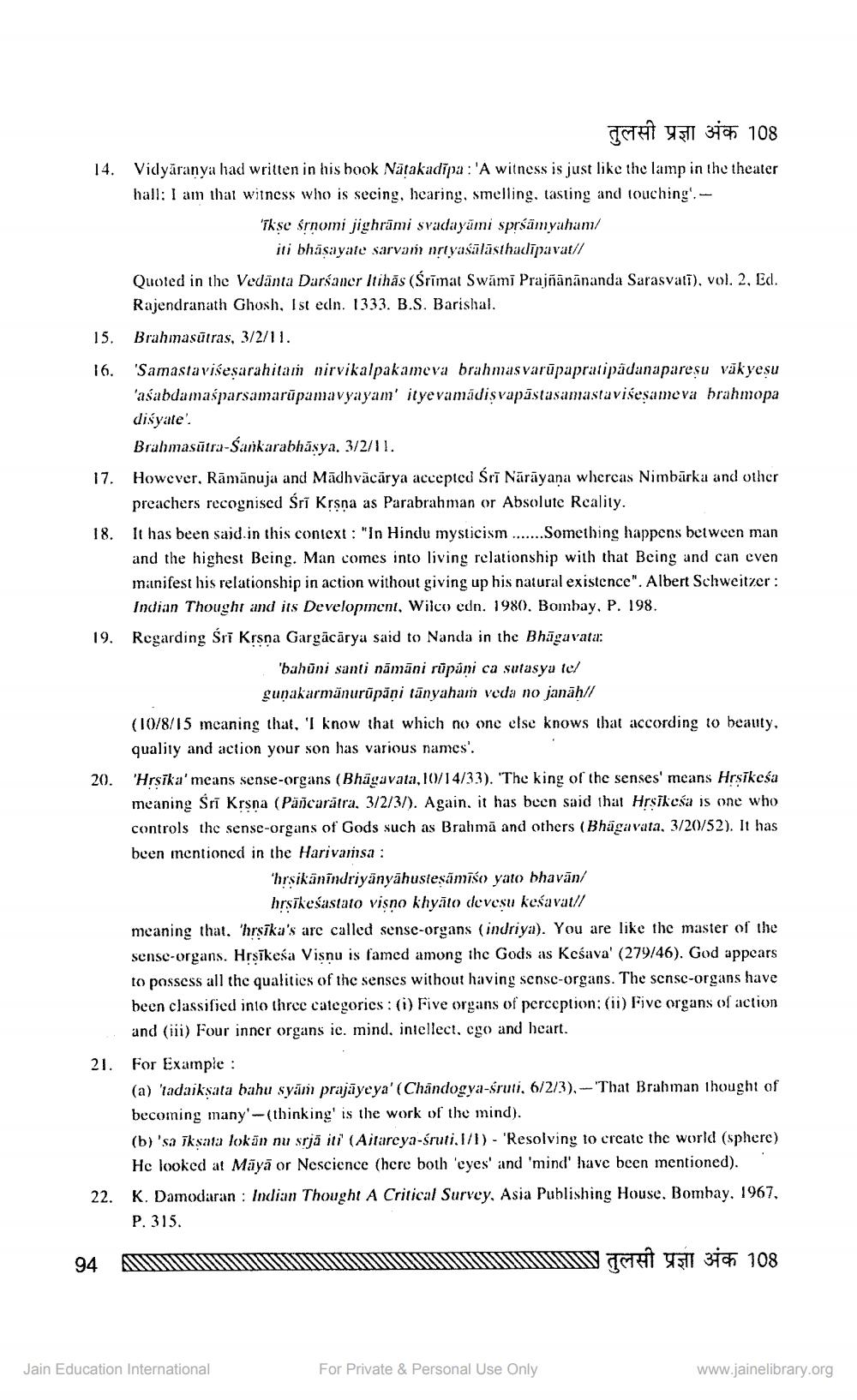________________
तुलसी प्रज्ञा अंक 108 14. Vidyaranya had written in his book Nāṭakadīpa: 'A witness is just like the lamp in the theater hall: I am that witness who is seeing, hearing, smelling, tasting and touching'.
15.
16.
Quoted in the Vedanta Darśaner Itihās (Śrīmat Swāmī Prajñānānanda Sarasvati), vol. 2, Ed. Rajendranath Ghosh, 1st edn. 1333. B.S. Barishal.
Brahmasutras, 3/2/11.
21.
Tkṣe śrnomi jighrami svadayāmi spṛśamyaham/ iti bhāṣayate sarvam nṛtyaśālāsthadipavat//
'Samastaviseṣarahitam nirvikalpakameva brahmas varūpapratipādanaparesu vākyeṣu 'asabdamasparsamarūpamavyayam' ityevamādiṣvapāstasamastavišeṣameva brahmopa
disyate'.
Brahmasūtra-Śankarabhāṣya, 3/2/11.
17. However, Rāmānuja and Madhvacārya accepted Śrī Nārāyaṇa whereas Nimbarka and other preachers recognised Śrī Kṛṣṇa as Parabrahman or Absolute Reality.
18.
It has been said.in this context: "In Hindu mysticism........Something happens between man and the highest Being. Man comes into living relationship with that Being and can even manifest his relationship in action without giving up his natural existence". Albert Schweitzer : Indian Thought and its Development, Wilco edn. 1980. Bombay, P. 198.
19. Regarding Śrī Kṛṣṇa Gargācārya said to Nanda in the Bhāgavata:
'bahuni santi nämäni rūpāņi ca sutasya te/ guṇakarmanurüpāṇi tanyaham veda no janāḥ//
94
20. 'Hrşika' means sense-organs (Bhāgavata, 10/14/33). The king of the senses' means Hrṣīkesa meaning Śrī Krsna (Pāñcarātra, 3/2/3/). Again, it has been said that Hrṣikeśa is one who controls the sense-organs of Gods such as Brahma and others (Bhagavata, 3/20/52). It has been mentioned in the Harivansa :
(10/8/15 meaning that, I know that which no one else knows that according to beauty, quality and action your son has various names'.
hrsikänindriyänyähusteṣāmīšo yato bhavan/
hrṣikeśastato visno khyāto devesu kesavat!!
meaning that. 'hrṣika's are called sense-organs (indriya). You are like the master of the sense-organs. Hṛṣīkesa Visnu is famed among the Gods as Kesava' (279/46). God appears to possess all the qualities of the senses without having sense-organs. The sense-organs have been classified into three categories: (i) Five organs of perception; (ii) Five organs of action and (iii) Four inner organs ie. mind, intellect, ego and heart.
For Example:
(a) tadaikṣata bahu syam prajayeya' (Chandogya-śruti, 6/2/3),-"That Brahman thought of becoming many'-(thinking' is the work of the mind).
(b) 'sa īkṣata lokan nu srja iti (Aitareya-śruti. 1/1) 'Resolving to create the world (sphere) He looked at Maya or Nescience (here both 'eyes' and 'mind' have been mentioned).
22. K. Damodaran: Indian Thought A Critical Survey, Asia Publishing House, Bombay, 1967, P. 315.
| तुलसी प्रज्ञा अंक 108
Jain Education International
For Private & Personal Use Only
www.jainelibrary.org




